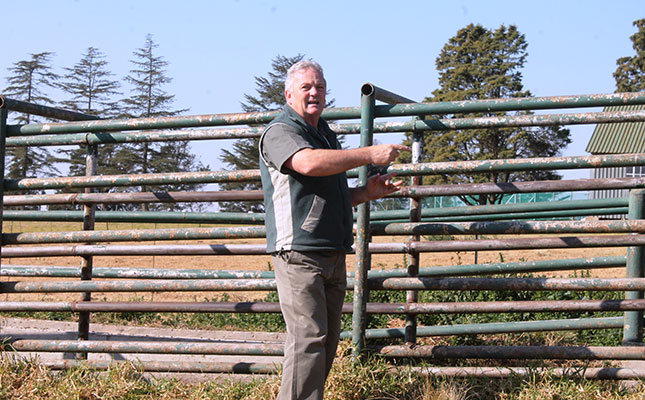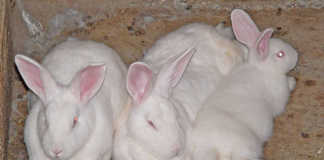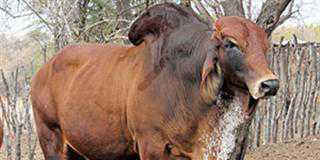
Photo: Lloyd Phillips
The US-published, but internationally read, Stockmanship Journal defines stockmanship as “the knowledgeable and skilful handling of livestock in a safe, efficient, effective and low-stress manner”.
However, and based on many informal surveys that Dr Johan Cloete has conducted of livestock owners and handlers over the years, in South Africa the use of stress-inducing methods such as whips, sticks, electric prodders, whistling, clapping, yelling and manhandling to move cattle is common.
Cloete, a ruminants technical veterinarian with MSD Animal Health, says these actions are
generally not due to deliberate malice towards the cattle, but mostly as a result of unintentional ignorance by livestock owners and cattle handlers.
Unfortunately, this ignorance can, and does, lead to not only cases of unnecessarily stressed cattle and resultant ill-health, lowered productivity and poorer quality beef or milk products, but also to damage to farm infrastructure and sometimes serious and potentially fatal injuries to cattle and people.
“The principles of handling both beef and dairy cattle are the same. When we work with cattle, we must create connections with the animals,” Cloete explains.
“Another important reason for handling cattle using low-stressmethods is to meet the increasing demand by consumers for improved animal welfare. An incident of animal abuse that is caught on camera and is easily shared on social media can do tremendous reputational damage to the beef and dairy industries.”
Prey animals
A key aspect to understanding cattle behaviour is to be aware hat they evolved as prey animals. A self-defence mechanism that cattle developed as a result of predation is having each eye set on either side of the head to give a wider view angle to look for potential predators.
However, this means that cattle have a blind spot directly in front of their heads, and another behind their rumps.
If cattle can hear, but are unable to see, potential threats, they become agitated as their fight-or-flight instinct kicks in. When cattle feel threatened in an open area, they tend to move away from the threat.
In an enclosed area where they cannot escape, they may try to force themselves out of the enclosure or may attack the threat, as a last resort. In this case, the cattle can injure themselves, one another, and any human in the enclosure, and may cause damage to infrastructure.
Cloete says that given these self-preservation adaptations, instincts and behaviour of cattle, the use of solid, high-sided cattle-handling chutes or of rail-sided chutes should depend on why the cattle are in the chutes in the first place. For example, a solid, high-sided chute is ideal for cattle that are being individually guided to an abattoir’s stun box.
A rail-sided chute is ideal for times when groups of cattle must be restrained to be given vaccinations or oral drenches. The space between the rails gives handlers easy access to either side of each animal for the purpose of carrying out these tasks.
“A common problem with the handling of cattle in rail-sided chutes is that the handlers are often in a rush, and they make loud sounds, whip the animals or use electric prodders to try to get the cattle into the chute and processed as fast as possible. This unnecessarily stresses the animals and can lead to many negative consequences, including having to chase stressed cattle around to try and get them into the chute,” Cloete explains.
Calm handlers
He, instead, advises handlers to have patience when dealing with cattle. He cites the Bud Williams Stockmanship principle that states that when cornered in an unfamiliar environment, cattle need seven seconds to analyse the situation and then turn around to move towards known areas within, or potential exits from, this environment.
If a particular animal is a herd leader, the rest of the herd will likely follow it and the handler can use this to his/her advantage.
“The bovine eye’s pupil is shaped flat horizontally. When the animal is stressed, the pupil widens to allow in more light to the retina. While this helps the eye to see more clearly at close range, it cannot clearly see objects that are farther away,” says Cloete.
“And because cattle also cannot see directly in front or behind themselves, a handler must take these various factors into consideration when wanting to move an animal in a particular direction without using stress-inducing methods.”
The first step for getting cattle to move in a particular direction is for handlers to position themselves on the opposite side towards which the animal needs to move.
The handler should also be within the animal’s viewing range. Each animal has its own ‘personal space’, and if a handler moves into this space, the animal begins feeling uncomfortable and automatically moves away from the handler.
Pressure
The handler must use an ‘add pressure, relax pressure’ method to get the cattle to move in the desired direction. If an animal is already aimed at or moving in the desired direction, the handler must keep adding pressure to the animal by slowly walking towards it at an angle that is parallel to, or oblique behind, the animal’s shoulder.
If the handler wants the animal to stop moving, he/she should relax pressure by stepping backwards away from the animal or by standing still.
Cloete says that to get cattle to turn around, the handler should move out of an animal’s personal space and then approach it from an angle that is oblique to the front of the animal’s shoulder.
As the handler moves towards the animal from this angle, the added pressure from the handler will make the animal uncomfortable and it will turn around to get away from this pressure.
To get an animal to move around a sharp corner in a handling chute, one handler should stand on the inside of the corner while a second applies pressure on the animal from an angle behind the appropriate shoulder.
Cattle prefer to walk around a perceived threat while keeping it in view. Due to their large size, they generally cannot turn fast, so the handlers should not chase them around the sharp corner, but rather allow the animal to walk quickly during this exercise to prevent
panic and possible injuries and infrastructure damage.
For cattle that need to be moved out of a relatively small holding enclosure, such as those
found at sales yards, the handler should enter the enclosure not through or over the enclosure sides, but via the gate.
This shows the cattle where the gate is.
Leaving the gate open, the handler should then slowly walk around one side of the
animal, putting pressure on it to move towards the open gate.
As one animal moves through the open gate, the rest of the herd will likely follow it out.
“Work with smaller batches of animals. We are inclined to work with big batches and this
often prevents the pressure-and-release technique from being correctly applied,” Cloete advises.
Cattle that are lying down while resting should also not be hurried to stand up and be moved. Like humans, they too need time to first stand up and stretch their muscles before moving.
Again, this consideration by handlers results in non-stressed cattle.
“Cattle that have been handled with stress-causing methods will need some time to get used to what is expected of them when they start being handled with the low-stress, add pressure, relax pressure method. But they learn fast and new animals into the herd will also learn from the original animals in the herd. And the use of low-stress handling methods eventually becomes second nature to a practised handler,” says Cloete.
He cautions that while the cattle are getting used to being handled using these low-stress
methods, there might be one or two animals that are perhaps wilder than the others and need a little more time to learn.
“Never jump in front of such animals when they are panicked. You could be seriously injured. Rather let this animal rejoin its herd mates until it has calmed down.”
Email Dr Johan Cloete at [email protected]. Visit msd-animal-health.com.
This information is from a presentation given by Cloete at a MSD Animal Health ‘Creating
Connections’ farmers’ information day held at Weston Agricultural College.











